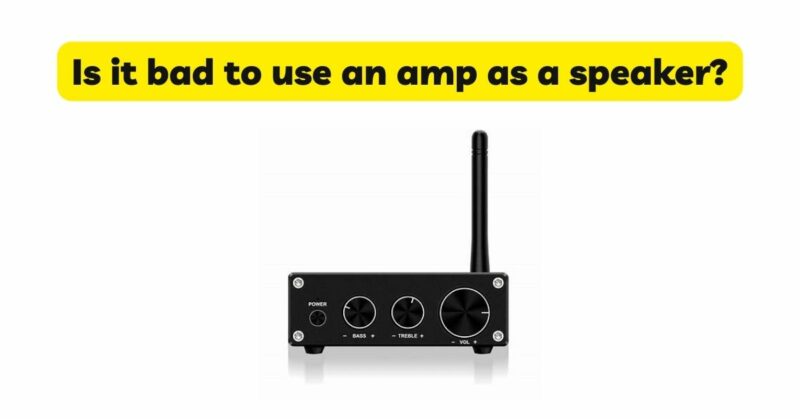Amplifiers and speakers are fundamental components of an audio system, each serving a distinct purpose. However, there may be situations where one considers using an amplifier as a speaker or connecting an audio source directly to an amplifier without a dedicated speaker. This article delves into the potential consequences and considerations of using an amp as a speaker, helping readers understand the implications and make informed decisions about their audio setups.
I. Understanding the Functionality of Amplifiers and Speakers:
- Amplifiers: Amplifiers receive an audio signal and increase its power to drive speakers. They play a crucial role in providing the necessary voltage and current to produce sound.
- Speakers: Speakers receive the amplified audio signal from the amplifier and convert it into audible sound waves through the vibration of diaphragms or cones. They are specifically designed to handle the power output and frequency response required for accurate sound reproduction.
II. Consequences of Using an Amp as a Speaker:
- Sound Quality: Amplifiers are not designed to function as speakers. Using an amp as a speaker can result in poor sound quality, with limited frequency response, distorted audio, and compromised dynamics. The lack of specialized speaker components can significantly impact the overall audio experience.
- Power Handling: Amplifiers are engineered to provide power to speakers, not to generate sound directly. They may not have the necessary power handling capabilities to produce sound on their own. Overloading an amplifier by using it as a speaker can lead to distortion, overheating, and potential damage to the amplifier.
- Impedance Mismatch: Amplifiers and speakers are designed to work together with proper impedance matching. Using an amp as a speaker can lead to impedance mismatch, where the amp’s output impedance does not match the expected load of a speaker. This can result in inefficient power transfer, instability, and potential damage to the amplifier.
- Safety Hazards: Using an amp as a speaker can create safety hazards. Amplifiers may not have the necessary built-in protection mechanisms found in speakers, such as thermal sensors or overload protection circuits. This increases the risk of damage to the amplifier and potential electrical hazards.
III. Considerations for Using an Amp as a Speaker:
- Audio Source Compatibility: Connecting an audio source directly to an amplifier without a speaker may seem like a simple solution, but it is essential to consider the compatibility between the audio source and the amplifier. Some audio sources may not provide an adequate signal level or impedance matching for direct connection to an amplifier.
- Power Limitations: Amplifiers have power ratings that indicate their maximum power output. If an amplifier is used as a speaker, it may not be capable of producing sound at the desired volume levels or handling the power requirements of the audio source.
- Equipment Damage: Using an amp as a speaker can potentially damage the amplifier due to overload, overheating, or other factors. The cost of repairing or replacing the amplifier could outweigh the initial convenience of using it as a speaker.
IV. Best Practices for Optimal Audio Setup:
- Use Dedicated Speakers: To ensure optimal sound quality and performance, it is recommended to use dedicated speakers designed to work with the amplifier. This ensures proper impedance matching, power handling, and accurate sound reproduction.
- Impedance Matching: When connecting speakers to an amplifier, ensure proper impedance matching. Consult the specifications of both the amplifier and the speakers to ensure compatibility and prevent potential issues.
- Consult Manufacturer Guidelines: Always refer to the manufacturer’s guidelines and specifications for your amplifier and speakers. Manufacturers often provide recommendations and limitations for the optimal use of their products.
- Consider a Preamp: If you need to connect an audio source directly to an amplifier without a dedicated speaker, consider using a preamp or a device designed to provide the necessary signal level and impedance matching. This can help mitigate some of the issues associated with using an amp as a speaker.
V. Conclusion:
Using an amplifier as a speaker may seem like a convenient solution, but it can result in compromised sound quality, power limitations, impedance mismatch, and potential equipment damage. It is advisable to use dedicated speakers designed for the amplifier’s output and to follow best practices for optimal audio setup. By understanding the consequences and considering the compatibility between your audio components, you can ensure a satisfying audio experience with proper sound reproduction, while preserving the longevity and integrity of your equipment.


